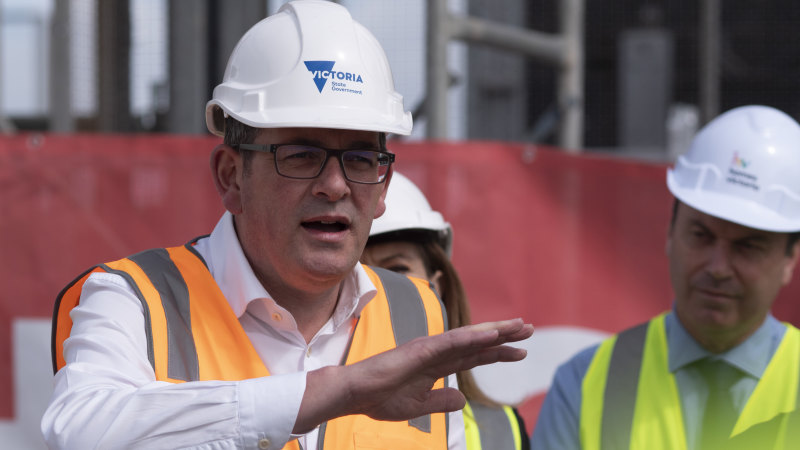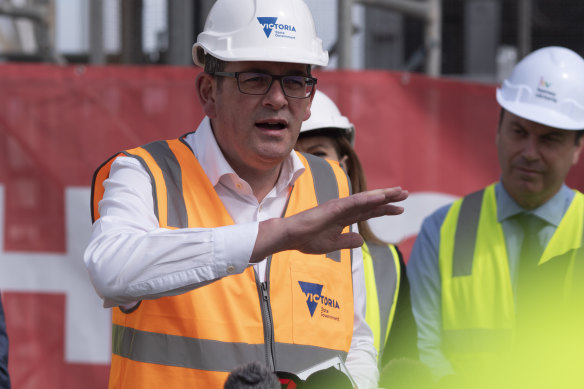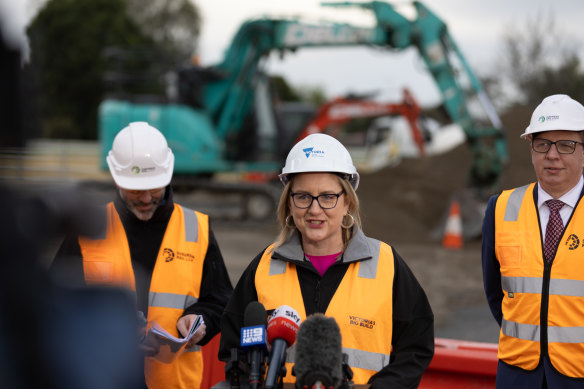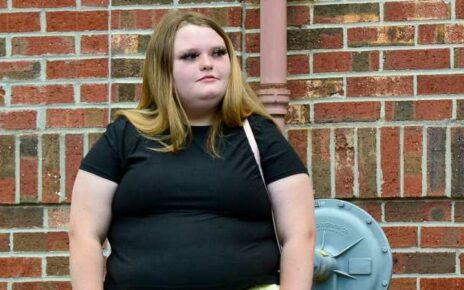Save articles for later
Add articles to your saved list and come back to them any time.
Victoria’s construction workforce is too small for the state government to meet its ambitious new home-building goal of 80,000 homes a year, construction experts and economists say.
The state government could be forced to consider pausing major infrastructure projects to free up workers and resources, and to boost its skilled migrant intake to achieve its target, experts suggest.
The number of workers employed in construction has dropped substantially in recent months.
Former Premier Daniel Andrews delivering the housing statement last monthCredit: Elke Meitzel
Last month, the state government revealed plans to build 800,000 new homes over a decade from 2024 to help fix the housing crisis, promising to ease planning restrictions, invest in social housing and unlock government land.
But construction experts and economists believe the state’s current construction workforce will be unable to meet the annual average target of 80,000 dwellings, which represents a sharp increase for the sector. According to the Australian Bureau of Statistics figures, when seasonally adjusted, 59,000 new dwellings were completed in Victoria in the year to March.
The latest labour force data from the ABS shows Victoria’s building and construction industry generated 333,165 full-time and part-time jobs in August 2023, representing a significant drop of 21,078 workers – or 6.3 per cent – from May 2023.
Senior lecturer in construction management at the University of Melbourne, Dr Paulo Vaz-Serra, told The Sunday Age “it’s clearly not possible” for the government to achieve its ambitious housing target with the current shortage of qualified labour.
“The 800,000 target is not based on an understanding of the current construction capacity,” Vaz-Serra said.
“Before starting on this ambitious program, they [the government] need to increase and incentivise young people to get into trades and combine that with an increase in immigrants with those specific skills.”
But Vaz-Serra warned that such a rapid expansion of the construction sector would run the risk of encouraging bad behaviour from the industry, which could affect both the quality and safety of new homes.
Experts are warning the government that it will struggle to achieve its ambitious housing target with the current shortage of qualified labour.Credit: Dion Georgopoulos
Master Builders Victoria chief executive Michaela Lihou said regional Victoria had suffered the largest drop in the number of construction workers, with an 11 per cent decrease. She urged the government to invest in innovation and training to ensure the industry was ready for the pipeline of work.
“Governments and stakeholders must continue to explore and strengthen opportunities across the innovation and education spaces to widen the pool of skilled workers so we can get the job done,” she said.
Dr Duncan Maxwell, director of Monash University’s Future Building Initiative, said training would be key to reaching the housing goal but “change is required” from both government and the construction industry to rethink the way we built homes.
He said to reach the goal, the sector would need to rely on technology and prefabricated materials, and focus on designing smaller and more efficient buildings.
“We need to look at new and innovative ways to build houses. We will need to do more with less; that’s fewer materials and less labour,” he said.
Maxwell said Victoria had the potential to achieve its 800,000 dwelling target, but not if it continued building homes in the same way, adding “we can’t continue to do the same thing”.
“There is a real opportunity to progress the industry to look at the problem more strategically,” he said.
A spokesperson for the Victorian government said on Saturday its “ambitious housing reform” would provide a pipeline of opportunities for skilled workers looking to make Victoria home.
“We’ve given industry the certainty they deserve and already we’ve received record levels of inquiries from industry ready to work with us to build the homes that Victorians need,” the spokesperson said.
“We’ve invested in training for the skills our economy needs through free TAFE, Big Build apprenticeships and Skills Solutions Partnerships – with more than 20 infrastructure-related courses available through free TAFE alone.”
When asked last month how Victoria could reach the 80,000 dwelling-a-year average given current workforce shortfalls, then premier Daniel Andrews said Labor had made record investments in TAFE, and its planning reform would remove the “terrible cloud of uncertainty” hovering over the construction sector.
“If you give industry certainty, they know they are going to get a quick approval for a high-quality product, they will take on an apprentice, and they will bid for the next job; they can expand and grow,” he said.
“I am very confident we will get this done,” he said, in what was his final major announcement before standing down as premier.
The Grattan Institute’s Brendan Coates said that while Victoria’s construction workforce had the capacity to grow, the government’s residential building target would be difficult to achieve alongside its current pipeline of major infrastructure projects.
Premier Jacinta Allan, pictured in August at early works for the Suburban Rail Loop project.Credit: Jason South
"There are only so many projects we can run at once, and it’s no longer clear that all the projects we need to move people around the city are as necessary now that people are spending more time at home," he said.
To avoid pausing major infrastructure projects, the state government would have to work with Canberra to develop new employer-sponsored pathways for construction workers and streamline skills assessments to meet the workforce demands created by the government’s housing plan, Coates said.
He said Australia’s migrant intake primarily consisted of international students, new graduates and working holidaymakers, all of whom were less likely to work in construction than other sectors of the economy.
"Migrants offer many benefits to Australia whether through skills or tuition fees, but they aren’t bringing the skills to deliver the homes we need to house them," he said.
Every infrastructure project in Victoria – except for Labor's signature Suburban Rail Loop – is currently under review as part of a national audit of Australia’s construction pipeline initiated by the Albanese government.
The Morning Edition newsletter is our guide to the day’s most important and interesting stories, analysis and insights. Sign up here.
Most Viewed in Politics
From our partners
Source: Read Full Article





